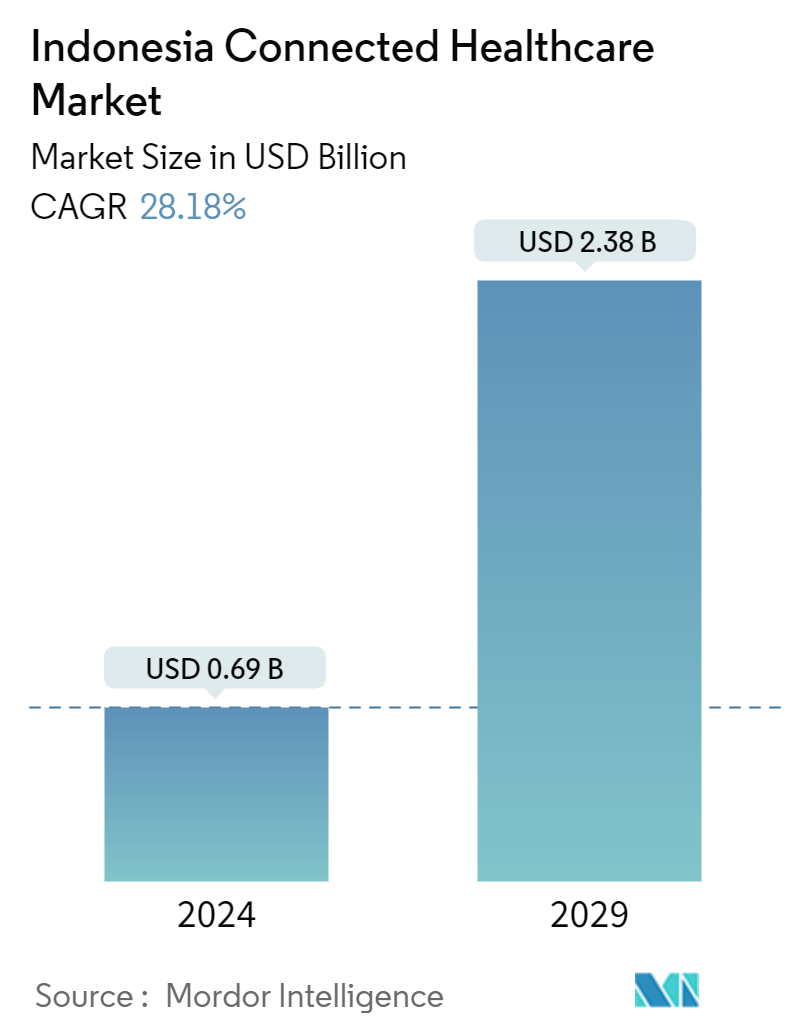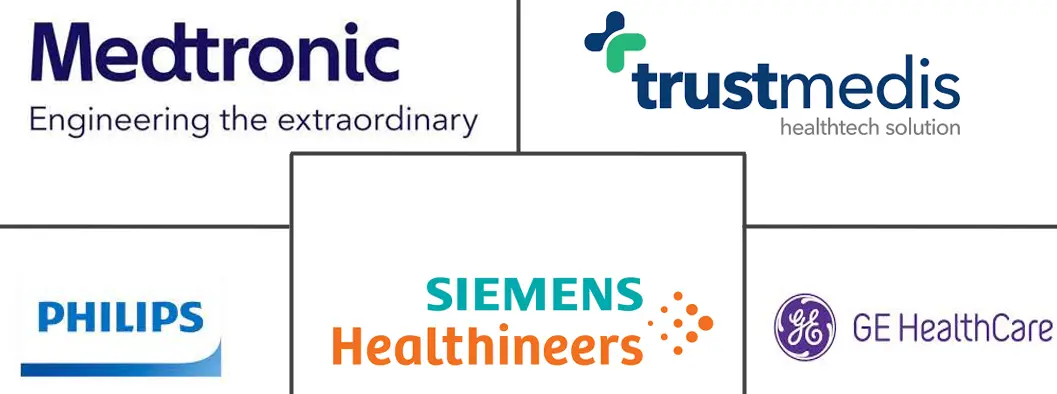Market Size of Indonesia Connected Healthcare Industry

| Study Period | 2019 - 2029 |
| Base Year For Estimation | 2023 |
| Market Size (2024) | USD 0.69 Billion |
| Market Size (2029) | USD 2.38 Billion |
| CAGR (2024 - 2029) | 28.18 % |
| Market Concentration | Medium |
Major Players
*Disclaimer: Major Players sorted in no particular order |
Indonesia Connected Healthcare Market Analysis
The Indonesia Connected Healthcare Market size is estimated at USD 0.69 billion in 2024, and is expected to reach USD 2.38 billion by 2029, growing at a CAGR of 28.18% during the forecast period (2024-2029).
- As spending by hospitals increases, followed by the need for health practitioners online, it is expected that health tech businesses will penetrate the market, resulting in the development of an environment needed for domestic platforms to partner with hospitals, driving growth in the studied market.
- Since the government of Indonesia started to boost health technology services in the country, the market has become more established with increasing demand. At present, Indonesia is home to many digital health start-ups, which are mainly dominated by e-pharmacy and online consultations. Other types of health technology businesses available in Indonesia include on-demand healthcare, online marketplaces, artificial intelligence (AI), and IoT. Some of the telemedicine providers are AloDokter and HaloDoc.
- Government initiatives to develop the healthcare ecosystem in Indonesia are expected to drive the growth of the market. For instance, in April 2023, the Health Ministry of Indonesia launched a regulatory sandbox system to develop the digital health innovation ecosystem in Indonesia that includes telemedicine.
- However, the availability of limited healthcare infrastructure is challenging the market's growth by adopting technology in various applications. For instance, Mayapada Healthcare Group in Indonesia faces challenges in implementing electronic medical records in its services. As a result, the group seeks to lead the healthcare industry’s digitalization by investing in AI and advanced hospital information systems.
- • Digital health is growing rapidly in Indonesia and has potential in the digital health business. As the ecosystem grows and the investment climate is favorable, more businesses are applying new and existing technologies. Secondly, Indonesia has a larger young demographic that is actively engaged with technology and benefiting from the development of internet connectivity. Such market conditions and geographical features have made Indonesia a key market and presented opportunities for digital healthcare.
- The COVID-19 pandemic catalyzed growth in Indonesia's connected healthcare sector. Lockdowns and social distancing measures prompted a shift toward remote healthcare, leading to a surge in demand for telemedicine consultations, remote patient monitoring, and medication deliveries. Government initiatives, such as providing and promoting telemedicine services, significantly bolstered this adoption. For instance, during the pandemic, the government of Indonesia provided free services for asymptomatic and mild COVID-19 patients, for which it collaborated with 11 telemedicine platforms to provide free telemedicine services and medicine delivery services.
Indonesia Connected Healthcare Industry Segmentation
Connected healthcare refers to the use of technology to deliver healthcare services remotely through leveraging a combination of internet connectivity, medical devices, and software applications to bridge the gap between patients and healthcare providers. The scope comprises revenue offerings in solutions and services among various applications.
The Indonesian connected healthcare market is segmented by offerings (solutions and services), applications (telemedicine, connected imaging, in-patient monitoring, and other applications), and region (Java, Sumatra, Kalimantan, and other regions). The market sizes and forecasts are provided in terms of value in (USD) for all the segments.
| By Offering | |
| Solution | |
| Services |
| By Application | |
| Telemedicine | |
| Connected Imaging | |
| In-patient Monitoring | |
| Other Applications |
| By Region | |
| Java | |
| Sumatra | |
| Kalimantan | |
| Other Regions (Sulawesi, Papua and Muluku, and Bali and Nusa Tenggara) |
Indonesia Connected Healthcare Market Size Summary
The connected healthcare market in Indonesia is experiencing significant growth, driven by increased hospital spending and the rising demand for online health practitioners. This growth is further supported by the government's initiatives to enhance health technology services, creating a conducive environment for domestic platforms to collaborate with hospitals. The market is characterized by a surge in digital health startups, particularly in areas such as e-pharmacy, online consultations, and telemedicine, with key players like AloDokter and HaloDoc leading the charge. The COVID-19 pandemic acted as a catalyst, accelerating the adoption of telemedicine and remote healthcare services, supported by government collaborations with telemedicine platforms to provide essential services during the crisis.
Despite challenges such as limited healthcare infrastructure, the Indonesian government is actively working to develop a robust digital health ecosystem. Initiatives like the regulatory sandbox system and collaborations with private telemedicine startups are expected to drive market expansion. The presence of a young, tech-savvy demographic and improved internet connectivity further bolster the market's potential. Major cities, particularly on the island of Java, are seeing increased investment in healthcare facilities, including international-standard hospitals, which are anticipated to boost demand for connected healthcare solutions. The market is moderately consolidated, with major players like Medtronic, Philips Indonesia, and GE HealthCare adopting strategies such as product innovation and partnerships to maintain competitiveness.
Indonesia Connected Healthcare Market Size - Table of Contents
-
1. MARKET DYNAMICS
-
1.1 Market Drivers
-
1.1.1 Rising Healthcare Spending
-
1.1.2 Government Support
-
-
1.2 Market Challenges
-
1.2.1 Limited Healthcare Infrastructure
-
-
1.3 Key Use Cases and Case Studies
-
-
2. MARKET SEGMENTATION
-
2.1 By Offering
-
2.1.1 Solution
-
2.1.2 Services
-
-
2.2 By Application
-
2.2.1 Telemedicine
-
2.2.2 Connected Imaging
-
2.2.3 In-patient Monitoring
-
2.2.4 Other Applications
-
-
2.3 By Region
-
2.3.1 Java
-
2.3.2 Sumatra
-
2.3.3 Kalimantan
-
2.3.4 Other Regions (Sulawesi, Papua and Muluku, and Bali and Nusa Tenggara)
-
-
Indonesia Connected Healthcare Market Size FAQs
How big is the Indonesia Connected Healthcare Market?
The Indonesia Connected Healthcare Market size is expected to reach USD 0.69 billion in 2024 and grow at a CAGR of 28.18% to reach USD 2.38 billion by 2029.
What is the current Indonesia Connected Healthcare Market size?
In 2024, the Indonesia Connected Healthcare Market size is expected to reach USD 0.69 billion.

